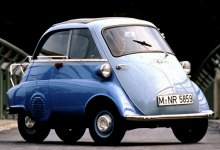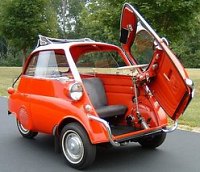  BMW is famous for producing performance saloons and coupes. However, without this micro car, BMW would have bankrupted in the late 50s. After WWII, Europe suffered from poor economy. BMW was also struggling for survival. Unfortunately, it found its 501 luxurious saloon born at a wrong time. Most people could only afford scooters and small vehicles. Big cars without established nameplates could hardly crack into the market. BMW saw the need to develop a cheap small car. In Italy, a scooter maker called Iso shared the same view. The only difference was that it saw this earlier than BMW and had already completed a micro car in 1953. The car was called "Isetta", meaning "Little Iso". Its design was ground-breaking: the passenger compartment had only one door, located at the front like a refrigerator. One row of seat can accommodate a couple of adults and a small child. Behind them was a two-stroke motorcycle engine. The Isetta measured just 2.3 meters long and 1.4 meters wide. It was inherently lightweight (350 kg), frugal and easy to park. Perhaps equally important was a funny styling - it looked like an egg on wheels ! This was exactly the car BMW desperately wanted, so it contacted Iso for licensing the production right. As Iso was a small company with little production volume, it was glad to make the deal and earn licensing fees. In 1955, the BMW Isetta was born. Although the design and concept came from Iso, BMW re-engineered all parts, including replacing the noisy two-stroke engine with a 4-stroke single-cylinder engine from its own R25 motorcycle. The 247 cc engine was not only more reliable than the Iso engine but also produced more power. With 12 horsepower at maximum, the car could run to 53 mph, not bad. To a small car, most costs were spent on sheet metal, engine and running gear. The Isetta had many clever designs to save costs. Its small size reduced the amount of steel used. Its single door was much cheaper than multiple doors. Ditto the single-cylinder engine and the lack of differential - yes, to save the need of differential, its rear track was made very narrow, measuring only 52 cm compare with 120 cm of the front track. This means the rear wheels were very close to each other thus their turning radius were also very close. But was it cheap? not really. The Isetta was a crossover between scooters and cars, but it was not much cheaper than a Volkswagen Beetle. It took about half a year wages of a regular German workman to buy. However, it was seen as a niche vehicle. People simply loved its funny look and the way to enter its cockpit from the front - very cool. When you saw the wealthy American also bought a lot of Isettas, you know it was sold by its charm rather than by low price. In 1956, the engine was enlarged to 298 cc. to improve torque and flexibility. BMW 600 - a 4-seat Isetta  In 1957,
BMW launched a 4-passenger version of the Isetta as a separate
line, the 600. It lengthened the wheelbase to accommodate the second
row seat and added a side door for access to the rear seat. The engine
was upgraded to a horizontally-opposed twin-cylinder displacing 600cc
(hence the name), again coming from BMW's motorcycle. The engine was
moved to behind the rear axle to prevent eating into passenger room and
to make it quieter. In 1957,
BMW launched a 4-passenger version of the Isetta as a separate
line, the 600. It lengthened the wheelbase to accommodate the second
row seat and added a side door for access to the rear seat. The engine
was upgraded to a horizontally-opposed twin-cylinder displacing 600cc
(hence the name), again coming from BMW's motorcycle. The engine was
moved to behind the rear axle to prevent eating into passenger room and
to make it quieter.As the economy of Western Europe, especially Germany, was booming since the late 50s, people migrated from micro cars to mini cars, especially BMC Mini. Isetta and 600 have finished their mission to save BMW. When they ceased production in 1962, close to 200,000 units had been produced. |